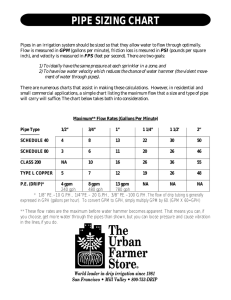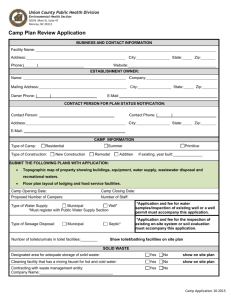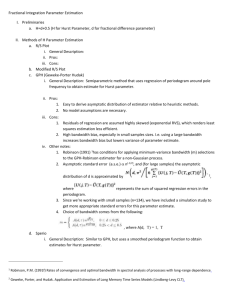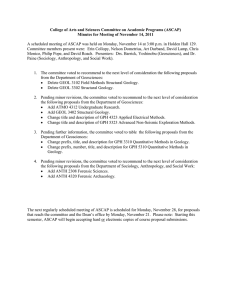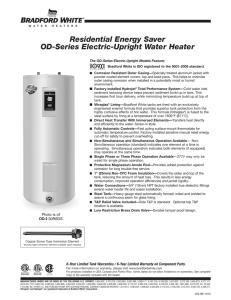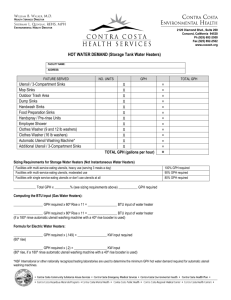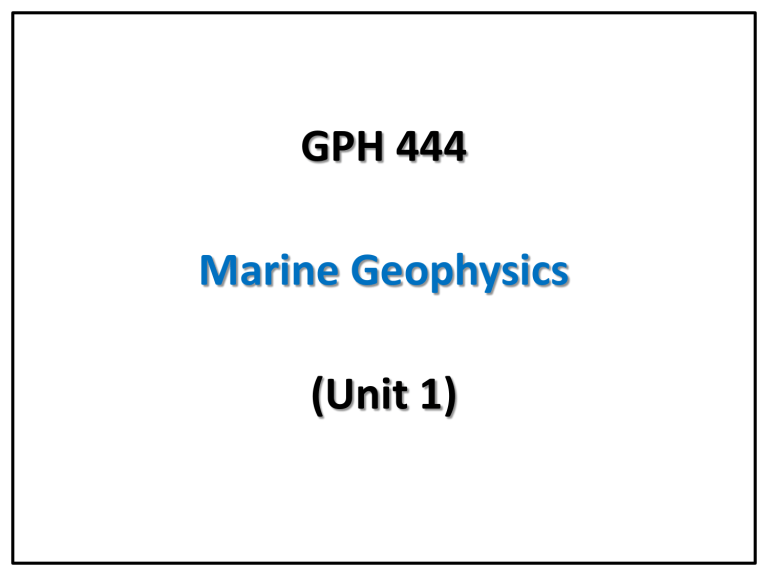
GPH 444 Marine Geophysics (Unit 1) Credits: 2 hours (2+0+0) Reference Book: • Marine Geophysics. E. J. W. Jones (1999), Wiley. • Applied High-Resolution Geophysical Methods. Offshore Geoengineering Hazard (1984). Peter K. Trabant, International Human Resources Development Corporation. GPH 444: Unit 1 (Introduction) Course Topics: Unit 1: Introduction. Unit 2: Marine Science. 1st Exam Unit 3: Marine Geotechnics. Unit 4: Echo Sounders. 2nd Exam Unit 5: Side Scan Sonar. Unit 6: Marine Magnetometers. 3rd Exam GPH 444: Unit 1 (Introduction) Grading: 1st Exam 2nd Exam 3rd Exam Final Exam 20% 20% 20% 40% GPH 444: Unit 1 (Introduction) Attendance: – Never to be late more than (10) minutes. – Never play with your cell phone. – Never talk to your friend. – Never miss more 25% of the total lectures. Participation: – Involve in all group discussions and activities. – Write down all important information in your notebook. GPH 444: Unit 1 (Introduction) Join a study group. Make study schedule. Arrange your time. Do your best. Seek advice. Learn from mistakes. Be patient. GPH 444: Unit 1 (Introduction) GPH 444: Unit 1 (Introduction) Learning Objectives By the end of unit (1) you should be able to recognize: 1. Earth's internal structure. 2. The difference between continental crust and oceanic crust. 3. Plate tectonic theory. 4. Types of plate boundaries. 5. How, where, and why earthquakes occur. 6. Wadati-Benioff zone. 7. Types & depths of earthquakes. 8. How to measure an earthquake. 9. The definition of geophysics. 10. Types of seismic waves. GPH 444: Unit 1 (Introduction) Rocks of the crust provide clues to Earth’s past. By analyzing these clues we can infer events from the past. GPH 444: Unit 1 (Introduction) Earth radius is the distance from Earth’s center to its surface which is about 6378 km. GPH 444: Unit 1 (Introduction) GPH 444: Unit 1 (Introduction) GPH 444: Unit 1 (Introduction) GPH 444: Unit 1 (Introduction) GPH 444: Unit 1 (Introduction) GPH 444: Unit 1 (Introduction) GPH 444: Unit 1 (Introduction) GPH 444: Unit 1 (Introduction) GPH 444: Unit 1 (Introduction) GPH 444: Unit 1 (Introduction) GPH 444: Unit 1 (Introduction) Definitions Earthquake: Vibration of the Earth produced by the rapid release of energy. Seismic waves: Energy moving outward from the focus of an earthquake. Focus (hypocenter): Location of initial slip on the fault; where the earthquake origins. Epicenter: Spot on Earth’s surface directly above the focus. GPH 444: Unit 1 (Introduction) GPH 444: Unit 1 (Introduction) GPH 444: Unit 1 (Introduction) GPH 444: Unit 1 (Introduction) GPH 444: Unit 1 (Introduction) GPH 444: Unit 1 (Introduction) GPH 444: Unit 1 (Introduction) GPH 444: Unit 1 (Introduction) GPH 444: Unit 1 (Introduction) GPH 444: Unit 1 (Introduction) Types of Earthquakes: The type of earthquake depends on the region where it occurs and the geological make-up of that region. 1. Tectonic Earthquakes: these occur when rocks in the earth's crust break due to geological forces created by movement of tectonic plates. 2. Volcanic Earthquakes: occur in conjunction with volcanic activity. 3. Collapse Earthquakes: are small earthquakes in underground caverns and mines. 4. Explosion Earthquakes: result from the explosion of nuclear and chemical devices. GPH 444: Unit 1 (Introduction) Depth of Earthquakes: 1. Shallow earthquakes: (Depth between 0 and 70 km). 2. Intermediate earthquake: (Depth between 70 and 300 km). 3. Deep earthquakes: (Depth is greater than 300 km). GPH 444: Unit 1 (Introduction) Measuring Earthquakes: Seismometers: instruments that detect seismic waves. Seismographs: Record intensity, height and amplitude of seismic waves. GPH 444: Unit 1 (Introduction) Geophysics: is the science which deals with investigating the earth, using the methods and techniques of physics. GPH 444: Unit 1 (Introduction) Geophysics = Geological Observations + Physical Laws GPH 444: Unit 1 (Introduction) GPH 444: Unit 1 (Introduction) GPH 444: Unit 1 (Introduction) Waves of energy that travel through the Earth's layers, and are a result of an earthquake, explosion, or a volcano. GPH 444: Unit 1 (Introduction) GPH 444: Unit 1 (Introduction) GPH 444: Unit 1 (Introduction) GPH 444: Unit 1 (Introduction) GPH 444: Unit 1 (Introduction) S-waves • Transverse. • Slow moving. • Travel through solids only. P-waves • Longitudinal. • Fast moving. • Travel through liquids and solids. GPH 444: Unit 1 (Introduction) Relationship between Vp and Vs: Compressional Waves: Shear Waves: • Averaged Vp/Vs = 1.732 for the crust. • For mafic rocks, Vp/Vs = 1.81. • For felsic rocks, Vp/Vs = 1.70. GPH 444: Unit 1 (Introduction) GPH 444: Unit 1 (Introduction) GPH 444: Unit 1 (Introduction) GPH 444 Marine Geophysics (Unit 2) Learning Objectives By the end of unit (2) you should be able to recognize: 1. The definition of oceanography and its divisions. 2. Role of oceans. 3. How to study oceans. 4. Instruments of investigation. 5. Driving forces & processes of evolution of ocean floor. 6. Wilson Cycle. 7. Bathymetry. 8. Divisions of ocean floor. 9. Classification of continental margins. 10. Ocean basin & mid‐oceanic ridge. GPH 444: Unit 2 (Marine Science) Ocean = the marine environment graphy = the name of a descriptive science Definition: Oceanography is the scientific study of all aspects of the marine environment. Oceanography = Oceanology = Marine Science GPH 444: Unit 2 (Marine Science) Marine Science Study: 1. The water of the ocean. 2. The life within the ocean. 3. The solid Earth beneath the ocean. GPH 444: Unit 2 (Marine Science) GPH 444: Unit 2 (Marine Science) Divisions of Oceanography: 1. Geological Oceanography (Marine Geology): study the structure of sea floor. 2. Chemical Oceanography (Marine Chemistry): study the chemical composition and properties of seawater. 3. Physical Oceanography (Marine Physics): study the waves, tides, and currents. 4. Biological Oceanography (Marine Biology): study the ocean life. GPH 444: Unit 2 (Marine Science) GPH 444: Unit 2 (Marine Science) GPH 444: Unit 2 (Marine Science) How to Study Oceans: GPH 444: Unit 2 (Marine Science) Instruments of Investigation: 1. SCUBA: is a Self‐Contained Underwater Breathing Apparatus. Tanks of compressed air strapped on a diver’s back and connected by hoses to a mouthpiece for breathing. GPH 444: Unit 2 (Marine Science) Instruments of Investigation: 2. SONAR: is a Sound Navigation And Radar. Methods of mapping the ocean floor by transmission and reflection of sound waves. GPH 444: Unit 2 (Marine Science) Instruments of Investigation: 3. Geostationary Operational Environmental Satellites (GOES): orbit the Earth at 22,000 miles. They are highly advanced observation platform supplying detailed imagery of the Earth’s oceans GPH 444: Unit 2 (Marine Science) Instruments of Investigation: 4. Deep Ocean Submersibles : Over the last few decades, engineers have developed technologies capable of meeting the many challenges that the deep sea imposes upon explorers. GPH 444: Unit 2 (Marine Science) Ocean floor is the bottom of the ocean (structures & features). (Ocean floor = Seafloor = Sea floor = Seabed) GPH 444: Unit 2 (Marine Science) GPH 444: Unit 2 (Marine Science) GPH 444: Unit 2 (Marine Science) Wilson Cycle: GPH 444: Unit 2 (Marine Science) GPH 444: Unit 2 (Marine Science) Bathymetry (bathy= depth, metry=measurement) Bathymetry is the measurement of ocean depths and the charting of the shape or topography of the ocean floor. GPH 444: Unit 2 (Marine Science) GPH 444: Unit 2 (Marine Science) GPH 444: Unit 2 (Marine Science) Divisions of Ocean Floor: 1. Continental Margins. 2. Deep‐ocean Basins. 3. Mid‐ocean Ridge. GPH 444: Unit 2 (Marine Science) Continental Margins: Continental margins are shallow‐water are close to continents. They are the zone of the ocean floor that separates the thin oceanic crust from thick continental crust. GPH 444: Unit 2 (Marine Science) Classifications of Continental Margins: 1. Passive Margins: are located at the transition between oceanic and continental crust which is not an active plate margin. 2. Active Margins: are those that are tectonically active, such as along much of the Pacific coast. 1. Convergent Active Margins. 2. Transform Active Margins. GPH 444: Unit 2 (Marine Science) GPH 444: Unit 2 (Marine Science) Continental Shelf: Continental shelf is a flat zone extending from the shore beneath the ocean surface to a point at which a marked increase in slope angle occur, called the shelf break. GPH 444: Unit 2 (Marine Science) Continental Slope: Continental slope is where the deep‐ocean basins begin. GPH 444: Unit 2 (Marine Science) Continental Rise: Continental slope is a transition zone between the continental margin and the deep‐ocean floor. GPH 444: Unit 2 (Marine Science) GPH 444: Unit 2 (Marine Science) Ocean Basin: Ocean basins are large geologic basins that are below sea level. GPH 444: Unit 2 (Marine Science) Mid‐Oceanic Ridge: A mid‐ocean ridge is a general term for an underwater mountain system that consists of various mountain ranges (chains) formed by plate tectonics. This type of oceanic ridge is characteristic of what is known as an oceanic spreading center, which is responsible for seafloor spreading. GPH 444: Unit 2 (Marine Science) GPH 444: Unit 2 (Marine Science) GPH 444: Unit 2 (Marine Science) GPH 444 Marine Geophysics (Unit 3) Learning Objectives By the end of unit (3) you should be able to recognize: 1. Marine geophysical survey methods. 2. Seabed (sub‐surface) geophysical surveys. 3. Seabed characteristic. 4. Development process. 5. Desk study. 6. Oil & gas offshore structure. 7. Marine vessel. 8. Engineering hydrographic & geophysical operations. GPH 444: Unit 3 (Marine Geotechnics) GPH 444: Unit 3 (Marine Geotechnics) GPH 444: Unit 3 (Marine Geotechnics) GPH 444: Unit 3 (Marine Geotechnics) GPH 444: Unit 3 (Marine Geotechnics) GPH 444: Unit 3 (Marine Geotechnics) GPH 444: Unit 3 (Marine Geotechnics) GPH 444: Unit 3 (Marine Geotechnics) GPH 444: Unit 3 (Marine Geotechnics) GPH 444: Unit 3 (Marine Geotechnics) GPH 444: Unit 3 (Marine Geotechnics) GPH 444: Unit 3 (Marine Geotechnics) GPH 444: Unit 3 (Marine Geotechnics) GPH 444: Unit 3 (Marine Geotechnics) GPH 444: Unit 3 (Marine Geotechnics) GPH 444: Unit 3 (Marine Geotechnics) GPH 444: Unit 3 (Marine Geotechnics) GPH 444: Unit 3 (Marine Geotechnics) GPH 444: Unit 3 (Marine Geotechnics) GPH 444: Unit 3 (Marine Geotechnics) GPH 444: Unit 3 (Marine Geotechnics) GPH 444: Unit 3 (Marine Geotechnics) GPH 444: Unit 3 (Marine Geotechnics) GPH 444: Unit 3 (Marine Geotechnics) GPH 444: Unit 3 (Marine Geotechnics) GPH 444: Unit 3 (Marine Geotechnics) GPH 444: Unit 3 (Marine Geotechnics) GPH 444 Marine Geophysics (Unit 4) Learning Objectives By the end of unit (4) you should be able to recognize: 1. Basic physics. 2. Underwater sound 3. Sound refraction. 4. Coastal variability. 5. Active & passive sonar. 6. Range estimation. 7. Echo sounders. 8. Properties in a sonar image. 9. Characteristic of sound in sea water. 10. Factors affecting choose of frequency. 11. Principle of echo sounder. 12. Reason for using sound waves. GPH 444: Unit 4 (Echo Sounders) GPH 444: Unit 4 (Echo Sounders) GPH 444: Unit 4 (Echo Sounders) GPH 444: Unit 4 (Echo Sounders) GPH 444: Unit 4 (Echo Sounders) GPH 444: Unit 4 (Echo Sounders) GPH 444: Unit 4 (Echo Sounders) GPH 444: Unit 4 (Echo Sounders) GPH 444: Unit 4 (Echo Sounders) GPH 444: Unit 4 (Echo Sounders) GPH 444: Unit 4 (Echo Sounders) Characteristic of Sound in Sea Water: a) Speed of sound: The speed of sound in sea water varies throughout the world with temperature, pressure due to depth, and salinity. An increase in any of these factors will cause an increase in speed of sound and vice versa. Even in the same place, temperature and salinity vary not only with depth but also from hour to hour. The speed of sound can vary from about 1445 m/s to 1535 m/s. GPH 444: Unit 4 (Echo Sounders) Characteristic of Sound in Sea Water: b) Spreading loss of sound in sea water: When sound is propagated into sea water the intensity decreases due to spreading. The actual intensity corresponds to power per unit area of cross section of wave front. The beam spreads out according to an inverse square rule. GPH 444: Unit 4 (Echo Sounders) Characteristic of Sound in Sea Water: c) Attenuation (Absorption of sound in sea water): As an acoustic wave propagates through sea water all of its energy ultimately converts to the heat due to viscosity and relaxation efforts. GPH 444: Unit 4 (Echo Sounders) Characteristic of Sound in Sea Water: d) Volume reverberation: When acoustic energy is propagated into sea water continuous returned echoes at the same frequency as the transmission are produced by back scattering from minute air bubbles, planktons, pollution, suspended sand and other discontinuities in the water. This is termed a volume reverberation signal and its magnitude increases dramatically with frequency. GPH 444: Unit 4 (Echo Sounders) Characteristic of Sound in Sea Water: In coastal regions the volume reverberation signal is high due to large concentrations of continental dust, pollution, plankton and small air bubbles. In mid ocean regions the scarcity of dust and pollution gives a reduced volume reverberation signal. In tropical mid ocean regions the disappearance of plankton results in a very low volume reverberation signal. GPH 444: Unit 4 (Echo Sounders) Factors Affecting Choose of Frequency: 1) Size and cost: Lower the frequency, larger and costlier the transducer. 2) Minimum attenuation (absorption): Higher the frequency (especially greater than 100 kHz), greater amount of absorption. 3) Minimum volume reverberation (for echo sounders) and more volume reverberation (for Doppler water speed logs): Higher frequency, greater amount of reverberation. 4) Free from ship noise (self-noise and ambient noise): Amount of noise is more at lower frequencies. GPH 444: Unit 4 (Echo Sounders) GPH 444: Unit 4 (Echo Sounders) GPH 444: Unit 4 (Echo Sounders) Echo sounders measure water depth by sending acoustic pulses through a transducer and picks up the reflected echoes. The depth is calculated from the two way travel time of the velocity of sound in water. As the vessel moves a single beam echo sounder (SBES) repeatedly "ping" the seafloor with a sound pulse, producing a discrete print of depths beneath the ship. GPH 444: Unit 4 (Echo Sounders) GPH 444: Unit 4 (Echo Sounders) GPH 444: Unit 4 (Echo Sounders) GPH 444: Unit 4 (Echo Sounders) GPH 444: Unit 4 (Echo Sounders) GPH 444: Unit 4 (Echo Sounders) GPH 444 Marine Geophysics (Unit 5) Learning Objectives By the end of unit (5) you should be able to recognize: 1. Components of an echo event at the sea floor. 2. Principles of side scan sonar. 3. Typical echo sounder output. 4. Sonograph characteristics. 5. Side scan sonar geometry. 6. Target material and orientation influences. 7. Vessel speed effects. 8. Types of side scan sonar. 9. Limitation of side scan sonar. GPH 444: Unit 5 (Side Scan Sonar) Components of an Echo Event at the Sea Floor Incident energy is partitioned between transmission into the sea floor and the echo, which is both reflection and scattering back into the water GPH 444: Unit 5 (Side Scan Sonar) GPH 444: Unit 5 (Side Scan Sonar) GPH 444: Unit 5 (Side Scan Sonar) GPH 444: Unit 5 (Side Scan Sonar) GPH 444: Unit 5 (Side Scan Sonar) GPH 444: Unit 5 (Side Scan Sonar) GPH 444: Unit 5 (Side Scan Sonar) GPH 444: Unit 5 (Side Scan Sonar) GPH 444: Unit 5 (Side Scan Sonar) GPH 444: Unit 5 (Side Scan Sonar) GPH 444: Unit 5 (Side Scan Sonar) GPH 444: Unit 5 (Side Scan Sonar) GPH 444: Unit 5 (Side Scan Sonar) GPH 444: Unit 5 (Side Scan Sonar) GPH 444: Unit 5 (Side Scan Sonar) GPH 444: Unit 5 (Side Scan Sonar) GPH 444: Unit 5 (Side Scan Sonar) GPH 444: Unit 5 (Side Scan Sonar) GPH 444: Unit 5 (Side Scan Sonar) GPH 444 Marine Geophysics (Unit 6) Learning Objectives By the end of unit (6) you should be able to recognize: 1. Magnetic prospecting. 2. The use of magnetometers. 3. Concept of marine magnetometers. 4. The use of magnetometers. 5. Application of marine magnetometers. GPH 444: Unit 6 (Marine Magnetometers) GPH 444: Unit 6 (Marine Magnetometers) The earth’s magnetic field is similar to that produced by a simple bar magnet placed in the center of the earth. The magnetic lines get into the earth from the north pole, and get out of it from the south pole. Thus the positive end of the bar magnet points to the south, and vice versa. GPH 444: Unit 6 (Marine Magnetometers) Introduction: Magnetometers measure minor differences in the strength of the Earth's magnetic field. Most sedimentary rocks are nearly non‐magnetic (although some sedimentary rocks such as sandstones can have local concentrations of magnetic minerals such as magnetite). Igneous rocks generally have a stronger magnetic effect. Because of these different effects on the magnetic field, measurements can be made to work out the vertical thicknesses and lateral distribution of rock units. GPH 444: Unit 6 (Marine Magnetometers) Introduction: In general, rocks containing magnetic minerals such as magnetite have greater magnetic susceptibility and therefore produce more intense magnetic readings. Major ore deposits (especially iron‐bearing units) have been discovered with magnetometers. A mass of iron locally intensifies the earth’s natural magnetic field. Magnetometers, installed in airplanes and boats, are routinely used in geophysical surveys. The location of large iron‐rich objects, such as sunken ships, can be accomplished using magnetometers. GPH 444: Unit 6 (Marine Magnetometers) Marine Magnetometers: A magnetometer is an instrument which measures the intensity of a magnetic field. Their application in geophysical prospection is founded on the principle that they can measure and record deviations in the Earth’s ambient magnetic field brought about by the presence of ferromagnetic material. GPH 444: Unit 6 (Marine Magnetometers) GPH 444: Unit 6 (Marine Magnetometers) Marine Magnetometers: Detect smaller targets farther away. Define smaller targets at higher survey speeds. Survey in areas with large steel anomalies and perform instrument checks on deck prior to survey. Better able to define large anomalies. Excellent performance for all applications, from small object detection to large geologic surveys. Magnetometer data can be used to map buried channels. Relative simple and cheap method. GPH 444: Unit 6 (Marine Magnetometers) GPH 444: Unit 6 (Marine Magnetometers) Explorer Is Ideal For: • Inshore, shallow water work. • Offshore towed behind side scans, AUVs and ROVs. • Inshore geophysical survey. • Archeology. • Wreck detention. • Magnetic mapping of harbors. • Ferrous target detection in lakes, rivers and estuaries. GPH 444: Unit 6 (Marine Magnetometers) Marine Magnetometers: Pressure vessel Sensor Collar weight Handle/CG Tow point Keel weight Cable cover Altimeter housing GPH 444: Unit 6 (Marine Magnetometers) GPH 444: Unit 6 (Marine Magnetometers) GPH 444: Unit 6 (Marine Magnetometers) GPH 444: Unit 6 (Marine Magnetometers)
